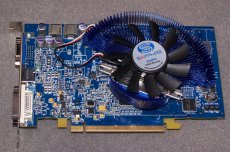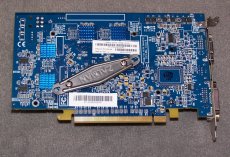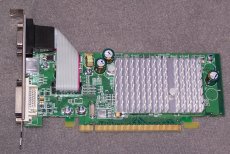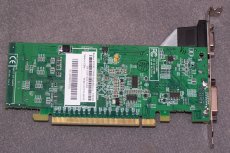On both boards the bridge chip is placed on the back of the PCB, and can run without a heatsink (although there may be a pad over the top on shipping versions to protect the resistors on the chip package), but where the graphics core positioning is roughly in the normal place of the X700 PRO AGP board (meaning the core and RIALTO packages overlap a little, but on opposite sides of the board) the X800 XL’s graphics core position is shifted a little to the left making for a longer board than the PCI Express X800 XL. Club3D have already sent Beyond3D an AGP Radeon X800 XL and we’ll be taking a look at this board shortly.
With the graphics vendors all producing boards that are very similar to the reference designs, if indeed they are not just the reference designs, they often seek other ways to differentiate themselves, and Sapphire are one of ATI’s noteable vendors in this respect. While they initially pioneered the "Ultimate" brand of Radeon’s, using Zalmans passive coolers, they have recently been pursuing the "Toxic" brand with the X800 PRO and X700 PRO. The Toxic X700 PRO distinguishes itself from other X700 PRO’s by utilising the ASIC’s for the now defunct X700 XT SKU and although Sapphire are not able to sell the boards preset to X700 XT speeds these boards are able to operate at, or beyond, X700 XT speeds. Sapphire are also in the process of developing a new overclocking tool to go along with their boards that will test the maximum levels the board can achieve and automatically set the clocks accordingly.
Sapphire X800 XL Ultimate Edition
Sapphire are also brining back the Ultimate brand, again using Zalman coolers attached to X800 XL’s. However, as heat output from modern graphics cores has increased they are not able to use fully passive designs; instead they have opted for Zalman’s very low noise "flower" design heatsinks. Sapphires Ultimate branded boards will continue to represent low noise boards, whilst Toxic boards represent overclockability.
Plenty of other vendors are also now catching on to the appeal of low noise boards and are also beginning to over passively cooled solutions. Although announced, but not yet fully benchmarked, also turning up on vendors stands were ATI’s X300 HyperMemory solutions, such as the Sapphire board above.
ATI were not willing to publicly comment on their expected forthcoming release of their next generation R520 core despite there being plenty of interest in it. One thing that did transpire during discussions with various ATI employees was that they have taken to heart some of issues that have been perceived in bringing boards to market, to the point where they mentioned in a recent investor conference that their CEO has been spending much time addressing the issues internally in order to be able to turn around new products faster, and as such there may be the possibility that they are not willing to announce R520 until they are much closer to being in volume. This could have some impacts on when we’ll hear announcements from ATI on R520.
We learnt from a vendor that although ATI recently demonstrated a 512MB X850 XT board, at present the schematics for this would not be available to board vendors, at least at this time, hence it does not look like we will even be seeing board vendor variations of such configurations just yet, if at all. It looks like ATI may not bring boards equipped with 512MB of local RAM into retail availability until R520 is released.
Finally we also heard that graphics cards may soon be receiving a new type of output port: HDMI. HDMI is a new interconnect that’s primarily being used with high resolution devices such as HDTV’s and uses the same signalling methods as DVI with the addition that it also carries audio signals. Hopefully other PC components, such as flat panels, will also transition across to these interconnects at some point in the future, but because PC’s are increasingly being used in Media Center type environments expect some graphics cards to support HDMI fairly soon. The smaller connector may also make it easier to support more outputs on a single board – that All-In-Wonder with dual digital outputs may not be such an impossibility now.








